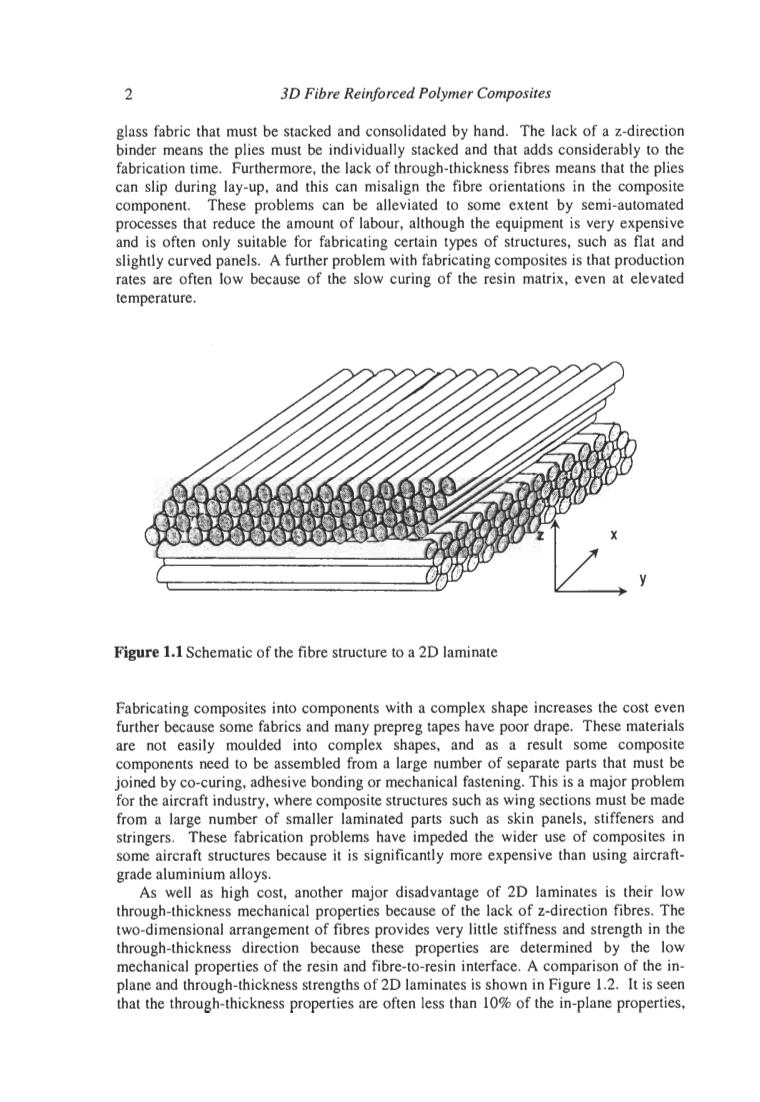正在加载图片...

2 3D Fibre Reinforced Polymer Composites glass fabric that must be stacked and consolidated by hand.The lack of a z-direction binder means the plies must be individually stacked and that adds considerably to the fabrication time.Furthermore,the lack of through-thickness fibres means that the plies can slip during lay-up,and this can misalign the fibre orientations in the composite component.These problems can be alleviated to some extent by semi-automated processes that reduce the amount of labour,although the equipment is very expensive and is often only suitable for fabricating certain types of structures,such as flat and slightly curved panels.A further problem with fabricating composites is that production rates are often low because of the slow curing of the resin matrix,even at elevated temperature. Figure 1.1 Schematic of the fibre structure to a 2D laminate Fabricating composites into components with a complex shape increases the cost even further because some fabrics and many prepreg tapes have poor drape.These materials are not easily moulded into complex shapes,and as a result some composite components need to be assembled from a large number of separate parts that must be joined by co-curing,adhesive bonding or mechanical fastening.This is a major problem for the aircraft industry,where composite structures such as wing sections must be made from a large number of smaller laminated parts such as skin panels,stiffeners and stringers.These fabrication problems have impeded the wider use of composites in some aircraft structures because it is significantly more expensive than using aircraft- grade aluminium alloys. As well as high cost,another major disadvantage of 2D laminates is their low through-thickness mechanical properties because of the lack of z-direction fibres.The two-dimensional arrangement of fibres provides very little stiffness and strength in the through-thickness direction because these properties are determined by the low mechanical properties of the resin and fibre-to-resin interface.A comparison of the in- plane and through-thickness strengths of 2D laminates is shown in Figure 1.2.It is seen that the through-thickness properties are often less than 10%of the in-plane properties,2 30 Fibre Reinforced Polymer Composites glass fabric that must be stacked and consolidated by hand. The lack of a z-direction binder means the plies must be individually stacked and that adds considerably to the fabrication time. Furthermore, the lack of through-thickness fibres means that the plies can slip during lay-up, and this can misalign the fibre orientations in the composite component. These problems can be alleviated to some extent by semi-automated processes that reduce the amount of labour, although the equipment is very expensive and is often only suitable for fabricating certain types of structures, such as flat and slightly curved panels. A further problem with fabricating composites is that production rates are often low because of the slow curing of the resin matrix, even at elevated temperature. Y Figure 1.1 Schematic of the fibre structure to a 2D laminate Fabricating composites into components with a complex shape increases the cost even further because some fabrics and many prepreg tapes have poor drape. These materials are not easily moulded into complex shapes, and as a result some composite components need to be assembled from a large number of separate parts that must be joined by co-curing, adhesive bonding or mechanical fastening. This is a major problem for the aircraft industry, where composite structures such as wing sections must be made from a large number of smaller laminated parts such as skin panels, stiffeners and stringers. These fabrication problems have impeded the wider use of composites in some aircraft structures because it is significantly more expensive than using aircraftgrade aluminium alloys. As well as high cost, another major disadvantage of 2D laminates is their low through-thickness mechanical properties because of the lack of z-direction fibres. The two-dimensional arrangement of fibres provides very little stiffness and strength in the through-thickness direction because these properties are determined by the low mechanical properties of the resin and fibre-to-resin interface. A comparison of the inplane and through-thickness strengths of 2D laminates is shown in Figure 1.2. It is seen that the through-thickness properties are often less than 10% of the in-plane properties